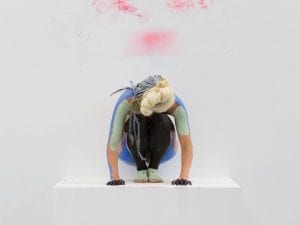For Frieze Masters 2016, Luxembourg and Dayan featured a collection derived from and inspired by the seminal L’Informe: mode d’emploi exhibition curated by Yves-Alain Bois and Rosalind E. Krauss at the Centre Pompidou in 1996. Based on a concept by Georges Bataille, who wrote in 1929: “formless is not only an adjective having a given meaning, but a term that serves to bring things down in the world, generally requiring that each thing have its form,” included were works by diverse artists such as Picasso, Manzoni, Twombly and others. Each work is iconoclastic in its throwing off of conventional art historical tropes; each piece a closer study of the materiality of the work of art in itself. As part of Formless Re-Examined, the gallery provided a rare opportunity to glimpse one of Claes Oldernberg’s iconic Fag-Ends, comically displayed out of place among the serene and manicured lawns within the Frieze Sculpture Park at Regent’s Park.
Almost in tandem, the gallery in London opened the first major UK solo exhibition of Italian artist Rodolfo Aricò. Subtitled Line of Demarcation, the show is presented as a body of work that explores what a catalogue entry by Giulio Carlo Argan on a 1967 exhibition by the artist called: “the critical point of passage from the state of the object to the state of the image and the contrary.” As well as this, the title alludes to the position of Aricò as a post-war Italian artist, complete with implications of Arte Povera, but also as one instrumental in the dialogue between American and European art in the 1960s and 1970s. Trained as an architect, Aricò was also an avid reader of philosophy and a talented writer.
The first impression that the works impart is that they are utterly untranslatable in reproduction. They must be viewed in person, because only then can the dialogue between the viewer and the works begin. This is mostly due to their nature as both architectural pieces, dealing with space, line and perspective; but also to their nature as phenomenological exercises.
The works appear deceptively simple, but they grow pleasingly more complex on closer inspection. With precise delineation, the artist created space and distance where there really is none. There is humour here, mostly due to the fact that never has nothingness been so pedantically rendered. Most of all however, there is questioning; encapsulated by the designation of the works as ‘object-paintings.’ When the subject of the painting is not a representation of something external or documentation of an instance, but an exploration of the painting itself, it becomes a commentary on what art actually is. This is a common theme in the practices of many artists working in the post-war period, including Yves Klein, Barnet Newman, Mark Rothko, Robert Rauschenberg, and Jackson Pollock, some of whom were featured in Formless Re-Examined.
Post-war art is defined by the fact that it is inescapably tied to the aftermath of a devastating global conflict; one whose consequences still ripple throughout the world. What purpose has art then, if the glorious achievements of the past come together so suddenly, and so close, to destroying us? And if for nothing, then why do we continue to produce it, to view it, to be moved by it? These are questions that are more relevant than ever today; when we are bombarded with images in no particular order, and with no specific purpose other than to be assimilated into our consciousness. Aricò’s object-paintings are decidedly integral to that struggle.
Laura Catsellis
Rodolfo Aricò, Line of Demarcation, until 17 December, Luxembourg and Dayan, London.
For more, visit www.luxembourgdayan.com.
For the latest news in contemporary art and culture, follow us on Facebook, Twitter and Instagram.
Credits
1. Rodolfo Aricò, Untitled, 1967. Courtesy of Luxembourg & Dayan.




